
|

|
Civil War Horses
The Horses of the Union and Confederate Armies
Civil War Horses
Life and Death of a Civil War Horse
| The Civil War horse |
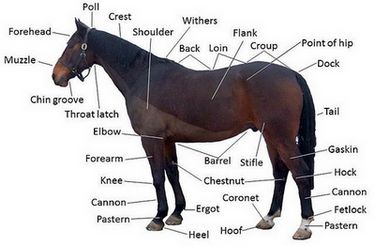
|
| Anatomy of the horse |
Introduction
The American Civil War (1861-1865) soldier preferred to shoot and
kill horses rather than enemy combatants, because without horses, artillery became passive objects of heavy metal and
without mounts the swift cavalryman was reduced to a plodding foot soldier now powerless to rapidly scout,
locate and strike the enemy and its supplies. Take away the horse, and the triune
army was stripped of two of its three major components, cavalry and artillery, leaving only disadvantaged infantrymen
to carry the brunt. While cavalry, consisting of the finest mounts and chargers, was considered the eyes and ears of
the army, the artillery branch, appreciating the brute strength of the solid-hoofed
animals, consisted of mammoth bronze and iron weapons that were capable of eliminating an overwhelming advancing
army.
During the conflict it is estimated
that between 1,000,000 and 3,000,000 equines died, including horses, mules, donkeys and even confiscated children’s
ponies. It is estimated that the horse casualties at the Battle of
Gettysburg alone, July 1 to July 3, 1863, exceeded 3,000. Diaries and letters of soldiers often mentioned the stench
of dead steeds rising up from the fields of battle.
| Dead Civil War Horse |
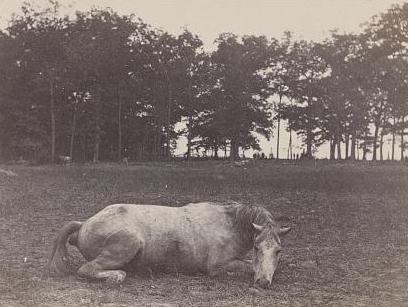
|
| Dead Horse of Confederate Colonel; both killed at Battle of Antietam |
In an account of the events at Gettysburg, General Gibbons of the Union Army made this observation of
the horses in Lieutenant Alonzo Cushing's 4th Artillery Brigade: One thing which forcibly
occurred to me was the perfect quiet with which the horses stood in their places. Even when a shell, striking in the
midst of a team, would knock over one or two of them or hurl one struggling in its death agonies to the ground, the rest would
make no effort to struggle or escape but would stand stolidly by as if saying to themselves, "It is fate, it is useless to
try to avoid it."
Horse and mule casualties far surpassed the total number of soldiers that
died during the conflict. And was the fate of soldiers, more equines perished from disease or exhaustion than from being
hit by bullets. Many died of glanders, which is a highly infectious disease that affects a horse’s nasal passages, respiration
and skin. Besides battle causalities, horses had difficulty maintaining the four
miles per hour pace regularly achieved by the cavalry. Horses also ate little and drank from muddied streams, and they often became
gaunt and sickly.
Union General William Sherman believed in the welfare and wellness of horses
and said that “Every opportunity at a halt during a march should be taken advantage of to cut grass, wheat, or oats
and extraordinary care be taken of the horses upon which everything depends.” Horses
were ridden by generals and cavalry, but also pulled cannons and supply wagons. They were the targets of fire, because if
you killed the horses, you halted the artillery movement or the cavalry charge.
Without mounts and mules, the Civil War would have been quite different because
the animals were absolutely indispensable to both sides. And they paid dearly as a result of that indispensableness,
as did many farmers and noncombatants, whose horses were confiscated routinely over the course of the war by both Union
and Confederate forces, leaving them without draft animals that they depended upon for their livelihood.
One cannot overstate the vital importance of both steeds and mules during the
Civil War. The cavalries on both sides rode them. The materiel and supplies
that each side depended upon was hauled by them. The artillery pieces and heavy guns could not be moved from battle to
battle, or maneuvered during the fight, without them. While horses carried the generals and other high ranking officers
into the fray, they also transported the wounded soldiers from the battlefield to the hospitals behind the lines. Whether
referred to as work horses or war horses, they were, truly, the backbone of the Army.
Dead Horse of Confederate Colonel; both killed at Battle of Antietam
On Sept. 19, 1862, just two days after the Battle of Antietam,
Alexander Gardner, an employee of the photographer Mathew Brady, began documenting the battle’s grim aftermath. One of Gardner’s photographs, titled “Dead Horse of Confederate Colonel;
both killed at Battle of Antietam,” depicted a milky-white steed lying on the field in an eerily peaceful repose.
Another showed a line of bloated Confederate bodies along the Hagerstown Pike. See also Life of a War Horse: From Farm to Battlefield to Aftermath of Civil War.
One who lost his horse at Antietam said, "The
third shell struck and killed my horse and bursting, blew him to pieces, knocked me down, of course, and tore off my right
arm..." Pvt. Ezra E. Stickley, Company A, 5th Virginia Infantry
Although by 1864 the sight of one dead horse was common place, the handsome mount
was difficult and costly to replace. It was also much easier to replace a soldier than a horse. As the conflict progressed,
the Union Army struggled to acquire the 500 horses it needed daily to sustain its army in the field. Sheridan himself required
150 additional steeds each day during the 1864 Shenandoah Valley Campaign. The army therefore bought and captured
nearly 210,000 horses in 1864 in order to offset the mounts that had died. If the soldiers had died at that rate, plus
wounded, it would have necessitated approximately 1,000,000 replacements, new recruits to be precise, to negate the shortfall
for said year. A daunting if not impossible task.
| More than 1,000,000 horses died in the Civil War |
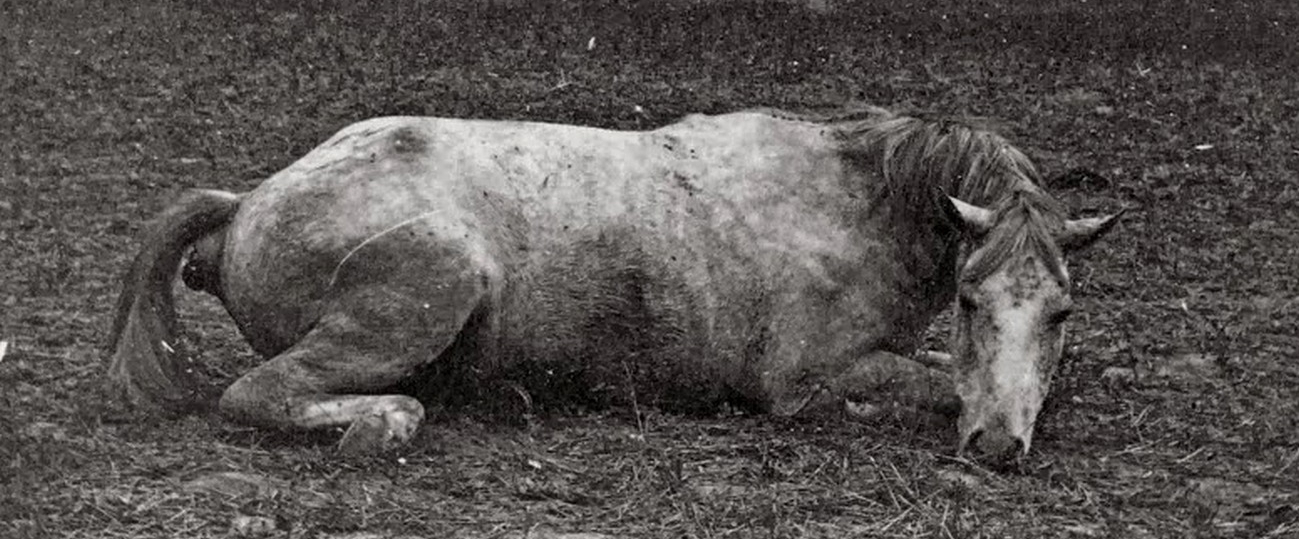
|
| Dead Horse of Confederate Colonel; both Killed at Battle of Antietam |
| Total Killed Civil War Horses |
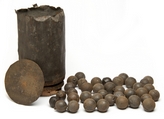
|
| 12-pounder canister shot |
(About) Dead Horse of Confederate Colonel; both killed at Battle of Antietam.
Retouched by the writer for clarity. View center mass of the mount, and you will see a very visible circular entry
wound indicating a large caliber, likely a canister ball (from cannon of course), that entered the gut
of the horse killing it instantly and therefore dropping him where he once stood. A horse in battle could generally
withstand several shots from small arms, but during the process it would run, unless it was tied, which was the practice of
horse artillery, and as it died, including the secured horse, it would merely collapse on its side or in an otherwise unnatural
position. The belief that it was canister shot is because of caliber, the immediate collapse and position of the horse, and
the rider, the colonel, appears to have been hit simultaneously with his stead. September
1862 at Antietam Battlefield. Alexander Gardner. Library of Congress.
(Left) Artilery shot-canister for a 12-pounder cannon from the Civil War era. From the collection
of the Minnesota Historical Society.
One witness at the awkward scene stated that "The
number of dead horses was high. They lay, like the men, in all attitudes. One beautiful
milk-white animal had died in so graceful a position that I wished for its photograph. Its legs were doubled under and its
arched neck gracefully turned to one side, as if looking back to the ball-hole in its side. Until you got to it, it was hard
to believe the horse was dead." - Union General Alpheus Williams, Antietam, September 22, 1862
| Life of a Civil War Horse |
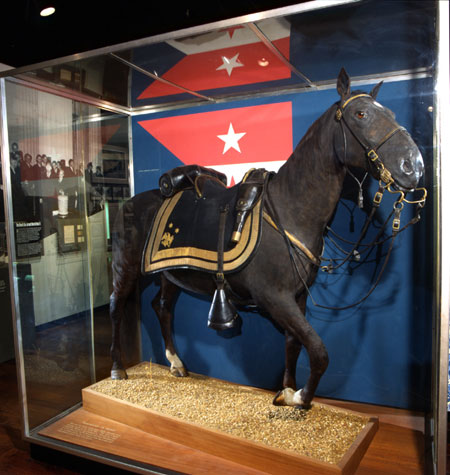
|
| Civil War Cavalry horse Winchester at Smithsonian |
The Cavalryman and his Horse
The Morgan mounted horse, 16 hands high, enshrined with Sheridan's black
horse blanket trimmed in gold with general’s insignia, and leather saddle.
"I could at any time control him by a firm hand and a few words,
and he was as cool and quiet under fire as one of my soldiers. I doubt if his superior as a horse for field service was ever
ridden by any one.” General Sheridan referring to Winchester
This Morgan horse was presented to General Philip Sheridan by the officers
of the Second Michigan Cavalry in 1862. He was three years old, jet black with three white fetlocks, and stood 16 hands high.
Originally called "Rienzi" after the town of Rienzi, Mississippi, his name was changed to "Winchester" by Sheridan after he
carried Sheridan on his famous ride from Winchester, Virginia, to Cedar Creek, Virginia on October 19, 1864, in time to rally
his troops and turn almost certain defeat into victory. While Cedar Creek was his most famous engagement, Winchester and Sheridan
were actually together for more than forty others. Winchester was even present at Appomattox Courthouse in April 1865 for
the official surrender of the Confederate Army.
Despite being wounded in battle several times, Winchester lived to be almost
20 years old. After his death in October 1878, he was preserved and mounted; in 1879, Sheridan presented him to the Military
Museum at Governor's Island, New York. Winchester was exhibited there until a fire in 1922 forced the museum to transfer him
to the Smithsonian Institution; a military escort accompanied him to his new home amid much fanfare. He was put on display
in the National Museum until 1964, when he moved to the newly opened National Museum of American History. The saddle, bridle,
and other trappings shown on Winchester were used by General Sheridan.
Horse and man have forever been immortalized and commemorated in poetry,
song, sculpture, museum exhibits and battlefield recollections. Portraits, sketches and poems all immortalized Sheridan’s
famous ride atop Winchester. The most famous of these poems was written by Thomas Buchanan Read, a painter; the poem, entitled
"Sheridan's Ride", became an instant sensation and was even thought to have helped Lincoln get reelected.
Famous Civil War Horses
Mounts of Civil War generals included: Traveller (Robert E. Lee); Old Sorrel
("Stonewall" Jackson); Cincinnati (Ulysses S. Grant); Lexington (William T. Sherman); Virginia (JEB Stuart); Daniel Webster
(George McClellan); Baldy (George Meade).
Eight Less Mounts
The Second Battle of Fredericksburg, or Battle of Marye’s Heights,
was fought, May 3, 1863, during the Chancellorsville Campaign (April-May 1863) in Virginia. Confederate
Gen. Robert E. Lee left Maj. Gen. Jubal A. Early to hold Fredericksburg on May 1, while he marched west with the rest of the
Army of Northern Virginia to engage Union Maj. Gen. Joseph Hooker's main thrust at Chancellorsville with four corps of the
Army of the Potomac. Early had his own division, along with William Barksdale's brigade from McLaws' division and cannons
from the artillery reserve. While Early was reinforced by Brigadier General William Pendleton of the artillery reserve, Cadmus
Wilcox's brigade arrived on May 3, increasing Early's strength to 12,000 men and 45 cannons. Most of the Confederate force
was deployed south of Fredericksburg.
| Casualties of Cannon |
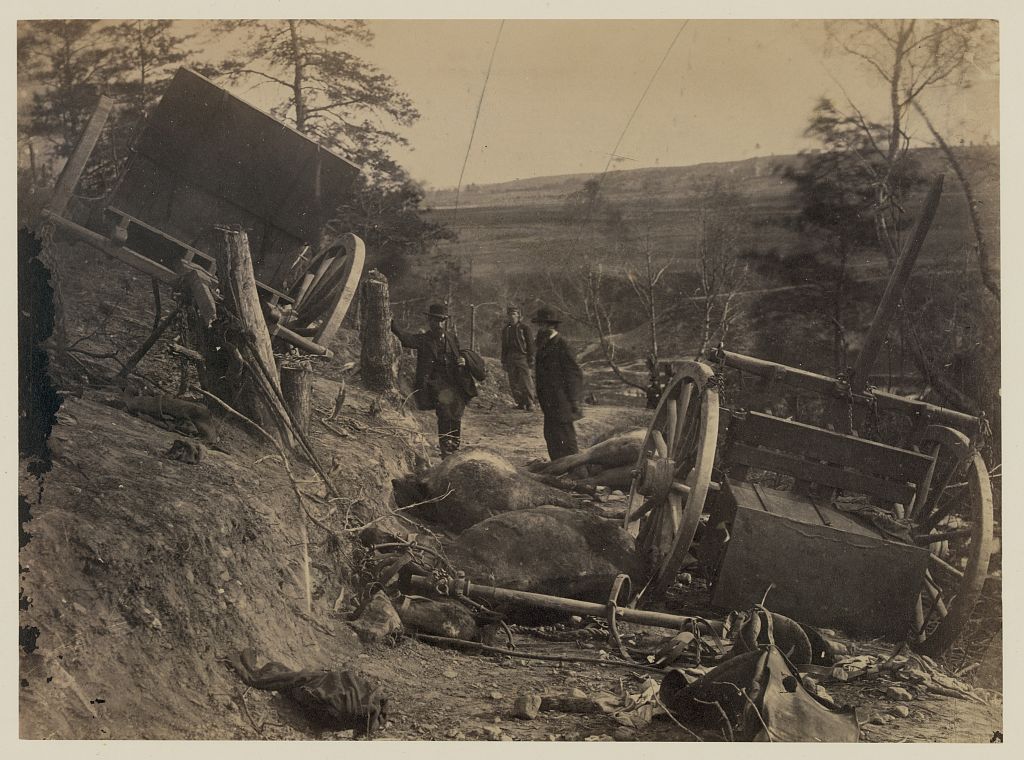
|
| Eight horses killed and one Rebel caisson destroyed by Federal shells at Fredericksburg, May 3, 1863 |
(Above) Union artillery eliminates one Confederate caisson and kills eight
horses during the Second Battle of Fredericksburg, May 3, 1863. While General Herman Haupt, W.W. Wright, and an unidentified
man viewed the scene of the destruction of Confederate caissons, they were also subjected to the stench of the eight horses
that had also been killed.
| Confederate dead at Fredericksburg |
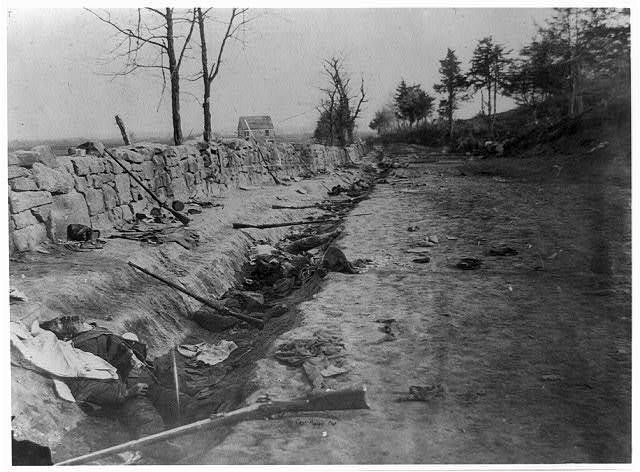
|
| Stone wall, rear of Fredericksburg with rebel dead, May 3, 1863 |
Early was ordered by Lee to observe the remaining Union force near Fredericksburg;
if he was attacked and defeated, he was to retreat southward to protect the Confederate supply lines. If the Union force moved
to reinforce Hooker, then Early was to leave a covering force and rejoin Lee with the remainder of his troops. On May 2, misunderstanding
his orders, Early left one brigade at Fredericksburg and moved the rest of his force towards Chancellorsville; Lee, however,
corrected the misunderstanding and Early then returned to his positions that night and before Sedgwick discovered the Confederate
retreat.
Maj. Gen. John Sedgwick was near Fredericksburg with the VI Corps, the I
Corps, and the II Corps division of Brig. Gen. John Gibbon. Hooker's plan called for Sedgwick to demonstrate near the city
in order to deceive Lee about the Union plan. The VI and II Corps seized control of several crossings on April 29, laying
down pontoon bridges in the early morning hours, and the divisions of W.H.T. Brooks and James S. Wadsworth crossed the river.
The I Corps was ordered to reinforce the main army at Chancellorsville during the night of May 1. During the evening of May
2, Sedgwick received orders to attack Early with his remaining forces.
Sedgwick moved his forces into Fredericksburg during dawn on May 3, uniting
with Gibbon's division which had crossed the river just before dawn. Sedgwick originally planned to attack the outskirts of
Marye's Heights but a canal and a stream blocked the Union forces. He then decided to launch an attack on the Confederate
center on the heights, which was manned by Barksdale's brigade, with John Newton's division; this attack was defeated. Colonel
Thomas M. Griffin of the 18th Mississippi Infantry granted the Union forces a truce in order to gather in their wounded. During
this truce, the Union commanders noticed that the flank of Barksdale's left regiment was unprotected.
Sedgwick launched his second attack against this flank and Barksdale's front
using elements from all three divisions of the VI Corps, which pushed the Confederate forces off the ridge, capturing some
artillery. The first men to mount the stone wall were from the 5th Wisconsin and the 6th Maine Infantry regiments. Barksdale retreated
to Lee's Hill, where he attempted to make a determined stand but was again forced to retreat southward.
Confederate casualties totaled 700 men and four cannons. Early withdrew
with his division two miles to the south, while Wilcox withdrew westward, slowing Sedgwick's advance. When he learned of the
Confederate defeat, Lee instructed two divisions to move east to halt Sedgwick. Following the campaign, Early became embroiled
in an argument with Barksdale over what Barksdale considered a slight to his brigade in a newspaper letter that Early had
written. The exchange continued, however, until Lee ordered the two generals to cease.
Sedgwick had lost 1,100 men during the engagement. Initially pursuing Early's
division, he quickly turned east, as instructed the previous day, along the Plank Road towards Hooker's army at Chancellorsville,
while Gibbon's division remained in Fredericksburg to guard the city.
| Civil War Cavalry Charge |
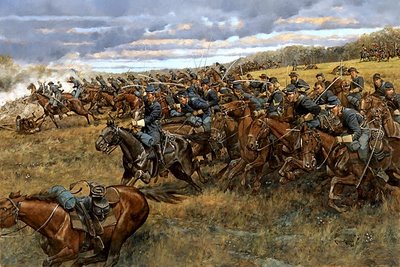
|
| Keith Rocco, renowned Civil War artist |
Largest Cavalry Duel
Fought on June 9, 1863, the Battle of Brandy Station, also known as the
Battle of Fleetwood Hill, was the largest predominantly cavalry engagement of the Civil War, as well as the largest ever to
take place on American soil. It was fought at the beginning of the Gettysburg Campaign by Union cavalry under Maj. Gen. Alfred
Pleasonton against Maj. Gen. J.E.B. Stuart's Confederate cavalry.
Pleasonton launched a surprise dawn attack on Stuart's cavalry at Brandy
Station, Virginia. After an all-day fight in which fortunes changed repeatedly, the Federals retired without discovering Gen.
Robert E. Lee's infantry camped near Culpeper. This battle marked the end of the Confederate cavalry's lopsided dominance
in the East. From this point in the war, the Federal cavalry gained strength and confidence.
Union casualties were 907 (69 killed, 352 wounded, and 486 missing,
primarily captured); Confederate losses totaled 523. Some 20,500 men were engaged in this, the largest predominantly cavalry
battle of the conflict. Among the casualties was Robert E. Lee's son, Rooney, who was seriously wounded in the thigh. He was
sent to Hickory Hill, an estate near Hanover Court House, where he was captured on June 26.
Stuart argued that the battle was a Confederate victory since he held the
field at the end of the day and had repelled Pleasonton's attack. The Southern press, however, was generally negative
about the outcome. The Richmond Enquirer wrote that "Gen. Stuart has suffered no little in public estimation by the late enterprises
of the enemy." The Richmond Examiner described Stuart's command as "puffed up cavalry," that suffered the "consequences of
negligence and bad management."
Subordinate officers criticized Pleasonton for not aggressively defeating
Stuart at Brandy Station. Maj. Gen. Hooker had ordered Pleasonton to "disperse and destroy" the Confederate cavalry near
Culpeper, but Pleasonton claimed that he had only been ordered to make a "reconnaissance in force toward Culpeper," thus rationalizing
his actions.
|

|

|

|

|
| The Mule that was killed-in-action |
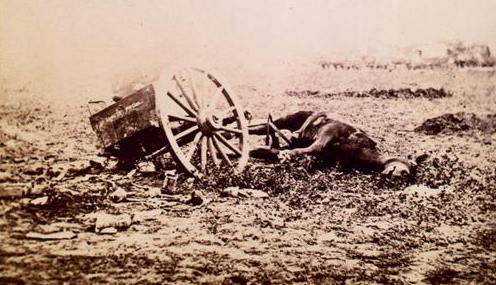
|
| Dead mule at Battle of Gettysburg |
(Above) Two views of the Trostle Farm. The 9th Massachusetts
Light Artillery Battery was posted at Abram Trostle's (i.e. Abraham Trossel's) house near Gettysburg, and, on July 2,
1863, the battery fought with fixed prolonges until the enemy was within six feet of the guns. During the onslaught,
the horses were also not exempt, and after the battle the dead horses covered the grounds of the farm. Library of Congress.
On an unusually hot day in July 1863, the 9th Massachusetts Battery was stationed
in the yard and barnyard of Trostle's place on the second day of the Battle of Gettysburg. A glimpse of the awful tide
of battle which they met there can be inferred from the fact that the battery lost 80 of its 88 horses in killed, leaving
the unit horseless. The views show where the guns stood. They held the fearful
charge in check until the lines could be reformed to successfully meet and repel the Confederate attack.
(Right) Artillery caisson and
dead mule on the battlefield of Gettysburg. Weapons don't discriminate on the killing fields, because steeds, mules, and even
ponies met death by the thousands during the Civil War.
A narrow farm lane that ran east to west beside the
Trostle buildings was used by Union artillery to reach positions near the Peach Orchard, and retreating artillerymen galloped their horses and guns back down the
same lane to make their way toward Cemetery Ridge. Most of the Union batteries made it except for the rookie 9th Massachusetts Battery, commanded by Captain John Bigelow. Bigelow's soldiers were in the first real battle they had ever experienced
and fought throughout the afternoon like veterans. After retiring to the Trostle buildings from the Wheatfield Road, Bigelow
was ordered to hold until a new artillery line could be formed on Cemetery Ridge. The men unlimbered the guns, loaded, and
grimly waited for the converging ranks of southerners to get closer. "The enemy approached over the knoll," Bigelow reported,
"Waiting till they were breast high, my battery discharged... double-shotted canister and solid shot. Through the smoke (I)
caught a glimpse of the enemy... torn and broken, but still advancing."
Bigelow's gunners kept up a steady fire, keeping the Confederates at a respectful distance until
orders to withdraw finally arrived. Quickly the men quickly limbered the guns. The first gun team rushed toward the single
gate near the house and had almost made it through when a wheel caught one of the posts, upsetting the gun in the gateway
and blocking it. Men rushed to unright the heavy gun and open the lane, but the battery was trapped, surrounded by stout fences
and stone walls. Bigelow ordered his gunners to unlimber again and reload with canister. Just as the first rounds were rammed
home, the 21st Mississippi Infantry broke through the dense smoke and pounced on the battery, shooting and cursing. Above
the din, someone shouted, "Shoot the horses!" and the animals fell in heaps still strapped to their harnesses. The artillerymen
fought back with hand spikes, rammers, pistols, and fists. "We fought with our guns until the rebs put their hands on (them),"
wrote Private David Brett. "The bullets flew thick as hailstones... It is a mericle(sic) that we were not all killed." The
survivors finally fled, leaving behind guns, limbers, and the wounded and dead intermingled with the dead and dying horses.
The first battle experience of the 9th Massachusetts Battery had ended in a bloody disaster. See also Battle of Gettysburg : The Trostle Farm and Plum Run.
Shenandoah Shambles
| Civil War horses |
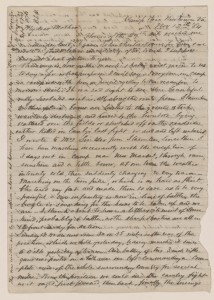
|
| Hundreds of dead horses... |
The Shenandoah Valley Campaigns of 1864 is generally regarded as the most
important of the Civil War campaigns conducted in the Shenandoah Valley of Virginia. Although the campaigns of 1864
lasted more than five months and claimed more than 33,000 casualties, it is one of the least studied and discussed campaigns
of the Civil War.
Virginia’s Shenandoah Valley was the scene of Stonewall Jackson’s
brilliant 1862 Valley campaign. It was also the breadbasket of Lee’s army. As part of his combined strategy in
1864, Grant consolidated his forces and put General Philip H. Sheridan in command of the valley, with orders to defeat Confederate
general Jubal Early and lay waste to this important rebel resource. According to Confederate Richard W. Habersham of Company
C, Manning Guard, from South Carolina, Sheridan was very thorough in carrying out Grant’s orders:
"It is a sad sight to see this beautiful valley desolated as it
is. All along the route from Staunton to this place houses are leveled to the ground & tack wantonly destroyed and horses
by the hundreds lying scattered over the fields or stretched off on the roadside either killed in Early’s last fight
or died and left unburied. . . . Marching on the turn pike, which is as hard as flint blistered my feet and made them so sore
as to be very painful. Our infantry is now in line of battle the bugle is sounding for the horses to be taken up and we are—I
think about to have a little excitement of some kind, probably a battle, as the sharpshooters are all in the front ready for
action." Richard W. Habersham to Harriett E. Habersham, November 12, 1864. Habersham Family Papers, Manuscript Division,
Library of Congress
The Shenandoah Valley was a vital asset to the Confederacy from the beginning of the Civil
War. In a human sense, the Valley became invaluable in its ability to feed soldiers in the field. Militarily, the Valley gave
the South a unique geographical advantage in the Eastern Theater. Because a Confederate force moving down the Valley would
be marching northeast, the Valley could conveniently deposit an army not far west of the U.S.
capital in Washington. On the other hand, United States forces in the Valley making a move southward would be taken away from the Confederate
capital in Richmond due to its southwest physicality. Another
advantage afforded Confederate forces in the Valley was the cover it provided. The mountains fronted an effective shield which
concealed the Southerners from prying Yankee eyes. Such secrecy was amply demonstrated in Jubal Early's raid on the defenses
of Washington in 1864. He nearly made it to the capital
before U.S. Grant even knew he was coming.
At the beginning of 1864, Ulysses S. Grant was promoted
to lieutenant general and given command of all Union armies. He chose to make his headquarters with the Army of the Potomac,
although Maj. Gen. George G. Meade remained the actual commander of that army. He left Maj. Gen. William Tecumseh Sherman
in command of most of the western armies. Grant understood the concept of total war and believed, along with Sherman and President
Abraham Lincoln, that only the utter defeat of Confederate forces and their economic base would bring an end to the war. Therefore,
scorched earth tactics would be required in some important theaters. He devised a coordinated strategy that would strike at
the heart of the Confederacy from multiple directions: Grant, Meade, and Maj. Gen. Benjamin Butler against Robert E. Lee's
Army of Northern Virginia near Richmond; Maj. Gen. Franz Sigel to invade the Shenandoah Valley and destroy Lee's supply lines;
Sherman to invade Georgia and capture Atlanta; Maj. Gen. Nathaniel Banks to capture Mobile, Alabama.
| Rienzi Winchester Sheridan |
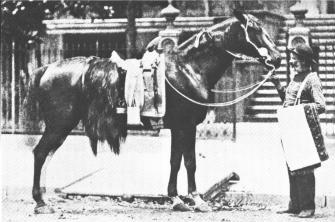
|
| Rienzi, ca. 1870s |
(Right) It was here in the Shenandoah
Valley Campaign of 1864, during a crushing Confederate defeat at the Battle of Cedar Creek, that Rienzi would be affectionately known as Winchester by Gen. Sheridan.
Robert E. Lee was concerned about the Union advance in the Valley during
1864, which threatened critical railroad lines and provisions for the Virginia-based Confederate forces. As a result, Lee
sent Jubal Early's corps, the Army of the Valley (independent command of the Army of Northern Virginia's Second Corps, renaming
it the Army of the Valley), to sweep Union forces from the Valley and, if possible, to menace Washington, D.C.,
hoping to compel Grant to dilute his forces against Lee around Petersburg,
Virginia.
The Confederacy's main objective of the entire series of battles
was to pull, draw or lure Grant's army and resources away from Lee, who was pinned down in the Richmond-Petersburg
Campaign (aka Siege of Petersburg), and consequently relieve Lee of the overwhelming Union resources that confronted
him. Although thousands of Union and Confederate soldiers died during the hotly contested Valley Campaigns, it is perhaps
the least studied and talked about of all the Civil War campaigns.
Originally organized as the Second Corps in Lee's army, Early's
Army of the Valley numbered approximately 14,000 soldiers. The infantry, totaling near 9,000, was organized into two corps,
each consisting of two divisions. The First Corps was commanded by Robert E. Rodes, a Virginia Military Institute graduate
and one of the highest-ranking Confederate officers not to have attended the U.S. Military Academy at West Point, New York.
The Second Corps, meanwhile, was led by John C. Breckinridge (cousin to Mary Todd Lincoln), the former U.S. vice president
under James Buchanan and a Democratic candidate for president in 1860 (ran against Lincoln). The North Carolinian Robert Ransom
commanded roughly 4,000 cavalrymen, organized into four brigades. Approximately sixteen artillery batteries supplemented the
army.
The Shenandoah Valley held considerable strategic and logistical
promise that attracted the attention of both Union and Confederate forces. The 1864 Valley Campaign far exceeded Confederate
general Thomas J. "Stonewall" Jackson's famed 1862 Valley Campaign in scope and impact. Early's Army of the Valley engaged
in systematic marching maneuvers up and down the Valley, engaged Union forces in numerous battles, offered resistance to Union
general Philip H. Sheridan's hard-war policies, invaded Maryland and Pennsylvania twice, and also ransomed and burned Northern
cities in hard-war tactics of its own.
Lt. Gen. Jubal Early's independent command during the Shenandoah
Valley Campaigns in the summer and autumn of 1864 was the last Confederate unit to invade Northern
territory, reaching the outskirts of Washington, D.C. The Army, however, became defunct after its decisive defeat at the Battle
of Waynesboro, Virginia, on March 2, 1865. The following month, Lee surrendered to Grant at Appomattox Court House on
April 9, thus ending four years of bloody conflict.
Sources: Library of Congress:
Civil War Photographs Collections Group; National Archives; Smithsonian Institution; Keith Rocco, artist; Official Records
of the Union and Confederate Armies; Cozzens, Peter. Shenandoah 1862: Stonewall Jackson's Valley Campaign. Chapel Hill: University
of North Carolina Press, 2008. ISBN 978-0-8078-3200-4; Magner, Blake A. Traveller & Company, The Horses of Gettysburg.
Gettysburg, PA: Farnsworth House Military Impressions, 1995. ISBN 0-9643632-2-4; Wert, Jeffry D. Cavalryman of the Lost Cause:
A Biography of J.E.B. Stuart. New York: Simon & Schuster, 2008. ISBN 978-0-7432-7819-5; Harper's Weekly Magazine, July
4, 1863, p. 424-425; Davis, Danny. "Return to Fredericksburg." America's Civil War 5, no. 4 (September 1992): 30–37;
Catton, Bruce. Glory Road. Garden City, New York: Doubleday and Company, 1952. ISBN 0-385-04167-5; Furgurson, Ernest B. Chancellorsville
1863: The Souls of the Brave. New York: Knopf, 1992. ISBN 0-394-58301-9; Gallagher, Gary W. "East of Chancellorsville: Jubal
A. Early at Second Fredericksburg and Salem Church" in Chancellorsville: The Battle and Its Aftermath, edited by Gary W. Gallagher.
Chapel Hill: University of North Carolina Press, 1996. ISBN 0-8078-2275-2; Sears, Stephen W. Chancellorsville. Boston: Houghton
Mifflin, 1996. ISBN 0-395-87744-X.
Return to American Civil War Homepage

|

|

|

